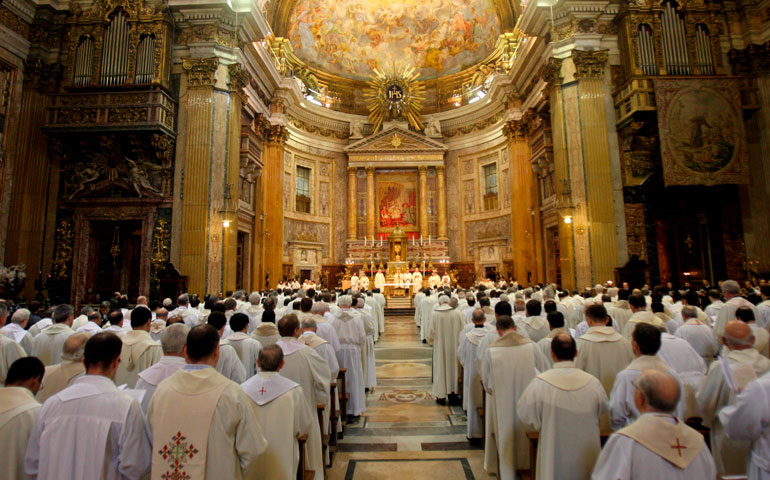
On Jan. 7, 2008, in Rome, a Mass opens the 35th General Congregation of the Society of Jesus in the Church of the Gesù, the Jesuits' mother church. (Newscom/EPA/Alessandro Di Meo)
The official logo for the 36th General Congregation of the Society of Jesus depicts a boat, representing the Jesuits, cast onto the seas. "Rowing Into the Deep" is the accompanying motto. There is no indication whether the seas are calm or turbulent, but the implication is that a captain is necessary.
Fr. Timothy Kesicki will be among 215 of his fellow Jesuits in Rome beginning Oct. 2 for the General Congregation, whose major task is to select a captain to guide the Jesuits -- to elect a new superior general. While the structure of the meeting is no secret, Kesicki, like other participants, has few clues about what its result will be. That's the way it should be, according to Jesuit protocol, which views the entire process as inspired by the Holy Spirit.
What Kesicki, president of the Jesuit Conference of Canada and the United States, does know is that the General Congregation's election of a new superior general is a big deal, not only for the Jesuits but for the wider church.
The Jesuits number around 16,000 worldwide, but exert an influence beyond their numbers in theology, Catholic university life, and the currents of Catholic social teaching, particularly in its emphasis on the preferential option for the poor. The latter is a principle Jesuit General Congregation 32 endorsed in 1974-75. It moved the Jesuits toward advocacy for oppressed and poor people around the world and was instrumental in the development of Latin American liberation theology.
 The Jesuits include in their number Jorge Bergoglio, now Pope Francis, who attended two previous general congregations but will not be attending this one. Francis is expected to fulfill the traditional papal role of blessing the results and welcoming the new superior general when he emerges.
The Jesuits include in their number Jorge Bergoglio, now Pope Francis, who attended two previous general congregations but will not be attending this one. Francis is expected to fulfill the traditional papal role of blessing the results and welcoming the new superior general when he emerges.
What makes general congregations important is their relative rarity. The Jesuits have been around 476 years and in that time have had only 30* superiors general. By contrast, Barack Obama is the 44th U.S. president since George Washington was inaugurated 228 years ago.
The first Jesuit General Congregation took place in 1558 to elect a successor to Ignatius of Loyola, the founder of the society. That meeting was delayed for two years because of war between the pope and the king of Spain. The longest general congregation, in 1645-46, took 145 days; the lengthiest modern congregation took place in two separate sessions in 1965-66, as the delegates took months, interrupted by a lengthy break, to thrash out the society's response to the Second Vatican Council (1962-65). That congregation also elected Fr. Pedro Arrupe, considered a giant among Jesuit leaders.
This year's congregation will include the election of a new superior general, who will take over from Fr. Adolfo Nicolás, 80, the current superior general, who is retiring.
"He's powerful," said Kesicki about the role of any superior general in the life of the Jesuit community. The superior general appoints major superiors throughout the world and, by carrying out the dictates of general congregations, can exert influence beyond the Jesuit community to the wider church.
The electorate this fall will include a relative handful of North Americans. Kesicki, by virtue of his position, is included, as are six conference superiors. This will be Kesicki's first General Congregation. Other representatives are elected at regional meetings. The size of each province matters: There will be five from the large Northeastern province, while smaller provinces, such as Oregon and Wisconsin, will have two representatives each.
In total, General Congregation representatives are regionally diverse: almost a third from Asia and the Pacific Islands, 27 percent from Europe, 16 percent from Latin America and 15 percent from North America. Out of these meetings, historic church figures have emerged.
One such figure is Arrupe, who shepherded the Jesuits through the aftermath of Vatican II and promoted social activism on behalf of the poor.
The upcoming General Congregation is the culmination of a process going back to December 2014, when Nicolás expressed his intention to resign. During the past two years, all the Jesuits of the world have been consulted about the future direction of the society at regional meetings.
When the group gets together in Rome, it will hear a report on the state of the Jesuits, accept the resignation of Nicolás, and then begin the process of deciding on a successor. After the new superior general is elected, the group will go over proposals suggested by Jesuits in the worldwide consultations. If enacted, these proposals will be binding on the entire society and on the superior general, akin to the U.S. president pledging fidelity to the U.S. Constitution, said Kesicki.
The process is in many ways similar to a papal conclave. The participants are bound by secrecy, and overt politicking is prohibited. For four days, the Jesuit electorate will be sequestered in what is called a murmuratio. They are asked at that time to reflect. Kesicki noted that many of the participants have little knowledge about each other, particularly those from different regions of the world. The doors will be closed.
"A lot will be about people getting to know one another," said Kesicki. Participants can only suggest and inquire about potential superior generals.
While no one is allowed to advocate for any emerging candidate, "the group finds a sense of who the superior general is" by asking fellow Jesuits who might have the leadership qualities needed, Kesicki said about the process.
"A sure way to get disqualified" is to offer any hint of overt electioneering, he said. Paper ballots are used and a simple majority can elect a new general.
Previous general congregations produced landmark decisions for the Society of Jesus. For example, the election of Arrupe brought the Jesuits into accord with Vatican II teachings on religious life and helped ignite the social activism that Jesuits brought to Latin America in the latter 20th century.
Some general congregations are called to address wide issues, beyond the election of a superior general. In 1983, the General Congregation tackled the then-new Code of Canon Law. The last general congregation, held in 2008, resulted in the election of Nicolás.
Kesicki, 53, said this congregation will be tilted toward younger Jesuits, an encouraging sign for the future. He is in the middle of the age range of participants. What will they be looking for in a new Jesuit superior general?
Kesicki said the new superior general can be expected to have strong language skills, needed in an international society. While all previous superior generals have come from Europe, the last three had substantial experience outside that continent -- Arrupe and Nicolás in Japan, and Fr. Hans Kolvenbach in the Middle East. Perhaps, as what occurred in the last papal conclave, a leader may emerge from outside Europe, particularly from high-growth regions of the worldwide South, from Asia, Africa or Latin America.
Wherever he comes from, the new Jesuit captain will be directing a ship at a propitious moment in Jesuit life. He will be working with a fellow Jesuit as pope, an unprecedented event. Francis' papacy has been marked so far by an ambitious agenda of reforming the governance of the church while addressing a world wracked by terrorism, massive population shifts from refugees fleeing war, income inequality, and the drastic decline of church participation in North America and Europe. Few expect the seas to be placid for whoever rows out into the deep as the new Jesuit superior general.
*An earlier version of this story listed an inaccurate number of superiors general, and has been corrected.
[Peter Feuerherd is a correspondent for NCR's Field Hospital series on parish life and a professor of journalism at St. John's University, New York.]




